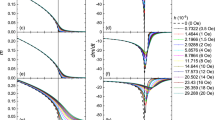Abstract
CURIE'S law states that ferromagnetics above the critical temperature behave in such a way that the susceptibility (k) is inversely proportional to the absolute temperature (T), in short, that the product k. T is a constant. The physical meaning of this law is that when the molecular magnets have complete freedom of rotational movements, the energy of magnetisation is then only opposed by the energy of thermal agitation and, consequently, any given state is a state of equilibrium.
This is a preview of subscription content, access via your institution
Access options
Subscribe to this journal
Receive 51 print issues and online access
$199.00 per year
only $3.90 per issue
Buy this article
- Purchase on Springer Link
- Instant access to full article PDF
Prices may be subject to local taxes which are calculated during checkout
Similar content being viewed by others
Rights and permissions
About this article
Cite this article
ASHWORTH, J. An Experimental Confirmation of the Kinetic and Molecular Theories of Magnetism. Nature 110, 10–11 (1922). https://doi.org/10.1038/110010b0
Issue Date:
DOI: https://doi.org/10.1038/110010b0
Comments
By submitting a comment you agree to abide by our Terms and Community Guidelines. If you find something abusive or that does not comply with our terms or guidelines please flag it as inappropriate.



